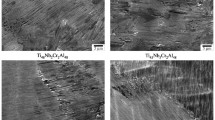Abstract
Transmission electron microscopy, X-ray diffraction analysis, and microindentation were used to study the changes in the structure, phase composition, elastic modulus, and hardness of the Ti–(9.6–34) at % Nb alloys after quenching in water from heating temperatures corresponding to the β region. The relationship between the physicomechanical properties (elastic modulus, microhardness) and the volume fraction of metastable phases detected in Ti–Nb alloys after quenching from the β region has been shown. It has been noted that the Ti–13.3 at % Nb alloy with a structure in which the ω phase with anomalous morphology in the form of massive plates is formed after quenching is characterized by maximum values of elastic modulus and microdurometric characteristics. The growth of the elastic modulus of the metastable β solid solution with increasing niobium content in alloys with a decrease in the average distance between the niobium–niobium atoms in the bcc structure has been justified. The possibility for calculating the elastic modulus of quenched Ti–Nb alloys based on the additive contributions of the elastic moduli of phases detected after quenching, which are proportional to their volume fractions has been considered.







Similar content being viewed by others
REFERENCES
T. Ozaki, H. Matsumoto, S. Watanabe, and S. Hanada, “Beta Ti alloys with low Young’s modulus,” Mater. Trans. 45, 2776–2779 (2004).
S. V. Grib, A. G. Illarionov, A. A. Popov, and O. M. Ivasishin, “Development and investigation of the structure and physical and mechanical properties of low-modulus Ti–Zr–Nb alloys,” Phys. Met. Metallogr. 115, 600–608 (2014).
V. A. Sheremetyev, S. D. Prokoshkin, V. Brailovski, S. M. Dubinskiy, A. V. Korotitskiy, M. R. Filonov, and M. I. Petrzhik, Investigation of the structure stability and superelastic behavior of thermomechanically treated Ti–Nb–Zr and Ti–Nb–Ta shape-memory alloys, Phys. Met. Metallogr. 116, 413–442 (2015).
S. G. Fedotov and O. K. Belousov, “Elastic constants in titanium–niobium system,” Fiz. Met. Metalloved. 17, 732–736 (1964).
A. G. Illarionov, N. V. Shchetnikov, S. M. Illarionova and A. A. Popov, “Effect of heating temperature on the formation of structure and phase composition of a biocompatible alloy Ti–6AL–4V–ELI subjected to equal-channel angular pressing,” Phys. Met. Metallogr. 118, 272–278 (2017).
H. Matsumoto, S. Watanabe, N. Masahashi, and S. Hanada, “Composition dependence of Young’s modulus in Ti–V, Ti–Nb, and Ti–V–Sn alloys,” Metall. Mater. Trans. A 37, 3239–3249 (2006).
M. Bönisch, M. Calin, J. Humbeeck, W. Skrotzki, and J. Eckert, “Factors influencing the elastic moduli, reversible strains and hysteresis loops in martensitic Ti–Nb alloys,” Mater. Sci. Eng., C 48, 511–520 (2015).
S. G. Fedotov and O. K. Belousov, “Elastic properties of alloys of titanium with molybdenum, vanadium, and niobium,” Sov. Ohys. Dokl. 8, 496–498 (1964).
S. G. Fedotov and O. K. Belousov, “Elastic properties of multi-component titanium alloys with molybdenum,vanadium and niobium,” Dokl. Akad. Nauk SSSR 155, 1387–1390 (1964).
C. M. Lee, C. F. Ju, and J. H. Chern Lin, “Structure–property relations of cast Ti–Nb alloys,” J. Oral Rehabil. 29, 314–322 (2002).
H. Ikehata, N. Nagasako, T. Furuta, A. Fukumoto, K. Miwa, and T. Saito, “First-principles calculations for development of low elastic modulus Ti alloys,” Phys. Rev. B 70, 174113 (2004).
J. Sun, Q. Yao, H. Xing, and W. Y. Guo, “Elastic properties of β, α” and ω metastable phases in Ti–Nb alloy from first-principles,” J. Phys.: Condens. Matter 19, 486215 (2007).
A. A. Popov, A. A. Il’in, A. G. Illarionov, O. A. Elkina, and M. Yu. Kollerov, “Study of phase transformations in quenched alloys of titanium–niobium system,” Fiz. Met. Metalloved. 78, 204–208 (1994).
A. G. Illarionov, A. A. Popov, S. V. Grib, and O. A. Elkina, “Special features of formation of omega-phase in titanium alloys due to hardening,” Metal. Sci. Heat Treat. 52, 493–498 (2010).
D. L. Moffat and D. C. Larbalestier, “The competition between martensite and omega in quenched Ti–Nb alloys,” Metall. Trans. A 19,1677–1686 (1988).
S. G. Fedotov, K. M. Konstantinov, R. G. Koknaev, and E. P. Sinodova, “Structure, properties and decomposition of martensite of titanium–niobium alloys,” in Titanium Alloys with Special Properties (Nauka, Moscow, 1982), pp. 29–33 [in Russian].
G. Aurelio, A. F. Guillermet, G. J. Cuello, and J. Campo, “Metastable phases in the Ti–V system: Part I. Neutron diffraction study and assessment of structural properties,” Metall. Mater. Trans. A 33, 1307–1317 (2002).
R. Banerjee, P. C. Collins, D. Bhattacharyya, S. Banerjee, and H. Fraser, “Microstructural evolution in laser deposited compositionally graded α/β titanium–vanadium alloys,” Acta Mater. 51, 3277–3292 (2003).
Y. Guo, K. Georgarakis, Y. Yokoyama, and A. R. Yavari, “On the mechanical properties of TiNb based alloys,” J. Alloys Compd. 571, 25–30 (2013).
Y. Mantani and M. Tajima, “Effect of ageing on internal friction and elastic modulus of Ti–Nb alloys,” Mater. Sci. Eng., A 442, 409–413 (2006).
S. Hanada, T. Ozaki, E. Takahashi, S. Watanabe, K. Yoshimi, and T. Abuyima, “Composition dependence of Young’s modulus in beta titanium binary alloys,” Mater. Sci. Forum 426–432, 3103–3108 (2003).
G. T. Aleixo, C. R. M. Afonso, A. A. Coelho, and R. Caram, “Effects of omega phase on elastic modulus of Ti–Nb alloys as a function of composition and cooling rate,” Solid State Phenom. 138, 393–398 (2008).
M. A. Shtremel’, Strength of Alloys. Ch. I. Defects of Lattice (Metallurgiya, Moscow, 1982) [in Russian].
B. N. Arzamasov, V. I. Makarov, G. G. Mukhin, et al., Materials Science, Ed. by B. N. Arzamasov and G. G. Mukhin (Izd-vo MGTU im. N.E. Baumana, Moscow, 2001) [in Russian].
ACKNOWLEDGMENTS
The work was supported in part by the Russian Science Foundation (project no. 18-13-00220). The authors are grateful to the program of support for the leading universities of the Russian Federation to increase their competitiveness no. 211 of the Government of the Russian Federation and no. 02.A03.21.0006 for financing the acquisition of microindentation tester.
Author information
Authors and Affiliations
Corresponding author
Additional information
Translated by O. Golosova
Rights and permissions
About this article
Cite this article
Illarionov, A.G., Grib, S.V., Illarionova, S.M. et al. Relationship between Structure, Phase Composition, and Physicomechanical Properties of Quenched Ti–Nb Alloys. Phys. Metals Metallogr. 120, 150–156 (2019). https://doi.org/10.1134/S0031918X19020054
Received:
Accepted:
Published:
Issue Date:
DOI: https://doi.org/10.1134/S0031918X19020054




